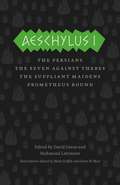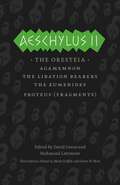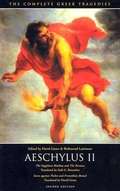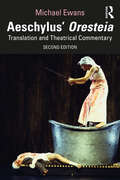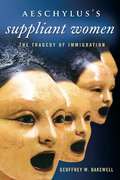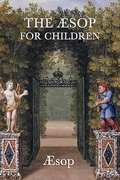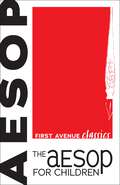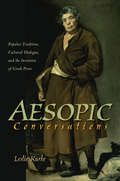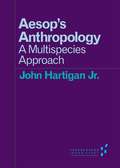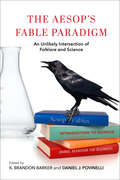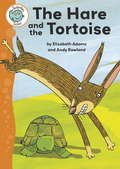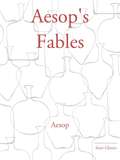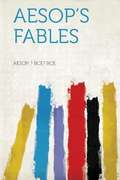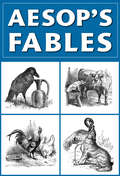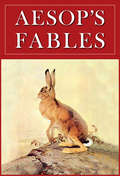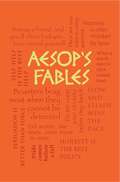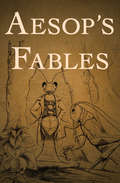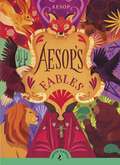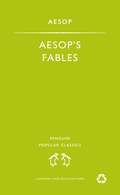- Table View
- List View
Aeschylus I: The Complete Greek Tragedies, Third Edition
by David Grene Richmond Lattimore"Aeschylus I" contains The Persians, translated by Seth Benardete; The Seven Against Thebes, translated by David Grene; The Suppliant Maidens, translated by Seth Benardete; and Prometheus Bound, translated by David Grene. Sixty years ago, the University of Chicago Press undertook a momentous project: a new translation of the Greek tragedies that would be the ultimate resource for teachers, students, and readers. They succeeded. Under the expert management of eminent classicists David Grene and Richmond Lattimore, those translations combined accuracy, poetic immediacy, and clarity of presentation to render the surviving masterpieces of Aeschylus, Sophocles, and Euripides in an English so lively and compelling that they remain the standard translations. Today, Chicago is taking pains to ensure that our Greek tragedies remain the leading English-language versions throughout the twenty-first century. In this highly anticipated third edition, Mark Griffith and Glenn W. Most have carefully updated the translations to bring them even closer to the ancient Greek while retaining the vibrancy for which our English versions are famous. This edition also includes brand-new translations of Euripides "Medea," "The Children of Heracles," "Andromache," and "Iphigenia among the Taurians," fragments of lost plays by Aeschylus, and the surviving portion of Sophocles s satyr-drama "The Trackers. " New introductions for each play offer essential information about its first production, plot, and reception in antiquity and beyond. In addition, each volume includes an introduction to the life and work of its tragedian, as well as notes addressing textual uncertainties and a glossary of names and places mentioned in the plays. In addition to the new content, the volumes have been reorganized both within and between volumes to reflect the most up-to-date scholarship on the order in which the plays were originally written. The result is a set of handsome paperbacks destined to introduce new generations of readers to these foundational works of Western drama, art, and life. "
Aeschylus II: The Oresteia (The Complete Greek Tragedies)
by AeschylusThis updated translation of the Oresteia trilogy and fragments of the satyr play Proteus includes an extensive historical and critical introduction. In the third edition of The Complete Greek Tragedies, Mark Griffith and Glenn W. Most have carefully updated the translations to bring them even closer to the ancient Greek while retaining their vibrancy for which the Grene and Lattimore versions are famous. New introductions for each play offer essential information about its first production, plot, and reception in antiquity and beyond.Each volume also includes an introduction to the life and work of the tragedian and an explanation of how the plays were first staged, as well as notes addressing textual uncertainties and a glossary of names and places mentioned in the plays. The result is a series of lively and authoritative translations offering a comprehensive introduction to these foundational works of Western drama.
Aeschylus II: The Suppliant Maidens, The Persians, Seven against Thebes, Promethus Bound (The Complete Greek Tragedies #2) (2nd edition)
by David Grene Richmond Lattimore AeschylusThis volume contains the other four plays of Aeschylus not included in Richmond Lattimore's version of the Oresteia. With these two volumes a complete English Aeschylus is before the reader.
Aeschylus' Oresteia: Translation and Theatrical Commentary
by Michael EwansThis is a fully revised new edition of Michael Ewans’ 1995 English translation of the Oresteia, taking into account the extensive work published on the trilogy in recent years.Accompanying this lucid, accurate and actable translation is a substantial introduction, outlining the festival setting of the plays, the original performance conditions and performance style, the form and meaning of the trilogy, the issues surrounding the act of translation, and finally a survey of some major productions since 1980. The text itself is a thoroughly competitive translation into modern English verse, now significantly revised in the light of recent scholarship on the text. It is followed by a theatrical commentary on each scene and chorus, providing unique insights into how the plays might have been staged in ancient Athens and how they can be staged today. The book also includes notes on the translation, two glossaries of names and Greek terms, selected further reading, and a chronology of Aeschylus’ life and times.Aeschylus’ Oresteia: Translation and Theatrical Commentary is the most comprehensive English edition of Aeschylus’ masterpiece, and this new edition fully meets the needs of teachers, students and practitioners working on the trilogy as well as those interested in ancient Greek drama and literature more broadly.
Aeschylus's Suppliant Women
by Geoffrey W. BakewellThis book offers a provocative interpretation of a relatively neglected tragedy, Aeschylus's Suppliant Women. Although the play's subject is a venerable myth, it frames the flight of the daughters of Danaus from Egypt to Greece in starkly contemporary terms, emphasizing the encounter between newcomers and natives. Some scholars read Suppliant Women as modeling successful social integration, but Geoffrey W. Bakewell argues that the play demonstrates, above all, the difficulties and dangers noncitizens brought to the polis. Bakewell's approach is rigorously historical, situating Suppliant Women in the context of the unprecedented immigration that Athens experienced in the sixth and fifth centuries BCE. The flow of foreigners to Attika increased under the Pisistratids but became a flood following liberation, Cleisthenes, and the Persian Wars. As Athenians of the classical era became increasingly aware of their own collective identity, they sought to define themselves and exclude others. They created a formal legal status to designate the free noncitizens living among them, calling them metics and calling their status metoikia. When Aeschylus dramatized the mythical flight of the Danaids from Egypt in his play Suppliant Women, he did so in light of his own time and place. Throughout the play, directly and indirectly, he casts the newcomers as metics and their stay in Greece as metoikia. Bakewell maps the manifold anxieties that metics created in classical Athens, showing that although citizens benefited from the many immigrants in their midst, they also feared the effects of immigration in political, sexual, and economic realms. Bakewell finds metoikia was a deeply flawed solution to the problem of large-scale immigration. Aeschylus's Argives accepted the Danaids as metics only under duress and as a temporary response to a crisis. Like the historical Athenians, they opted for metoikia because they lacked better alternatives.
Aeschylus's the Oresteia (Modern Critical Interpretations)
by Harold BloomEssays by John Jones, Anne Lebeck, Froma I. Zeitlin, Pierre Vidal-Naquet, W. B. Stanford, and John Herington.
Aesop and the CEO: Powerful Business Lessons from Aesop and America's Best Leaders
by David NoonanIt is easy to be overwhelmed by the sheer volume of business books flooding the market today. Even more daunting is the task of weeding through them to find the "golden nugget" of wisdom inside. Now David Noonan has simplified the process by providing this well-researched primer of the most essential advice from the greatest business books ever written. Further, in a clever melding of modern business sense and ancient wisdom, he has used the animal-based stories of Aesop as springboards to launch these 50 lessons. Both entertaining and informative, Aesop the CEO includes advice from well-known leaders such as Bill Gates, Sam Walton, Donald Trump, and Lee Iacocca. The short, easy-to-read vignettes cover every aspect of corporate life: negotiations, hiring and firing, mergers and acquisitions, marketing and sales, and day-to-day management.
The Aesop for Children
by AesopAccording to the Greek historian Herodotus, the fables were written by a slave named Aesop, who lived in Ancient Greece during the 5th century BCE. Aesop's fables and the Indian tradition, as represented by the Buddhist Jataka Tales and the Hindu Panchatantra, share about a dozen tales in common, although often widely differing in detail. There is therefore some debate over whether the Greeks learned these fables from Indian storytellers or the other way, or if the influences were mutual.
The Aesop for Children (First Avenue Classics ™)
by AesopAesop's famous collection of fables are intended to teach a variety of moral lessons. But instead of being long-winded and serious, these lighthearted tales are full of talking animals and often silly situations. Featuring such popular fables as "The Lion and the Mouse" and "The Fox and the Grapes," this collection is sure to entertain readers of any age. While the existence of Aesop's fables dates back to 6th century BCE, this version is taken from a 1919 copyright edition, with original illustrations by Milo Winter.
Aesop Kathakal
by AesopThis ebook is from DC Books, the leading publisher of books in Malayalam. DC Books' catalog primarily includes books in Malayalam literature, and also children's literature, poetry, reference, biography, self-help, yoga, management titles, and foreign translations.
Aesopic Conversations
by Leslie KurkeExamining the figure of Aesop and the traditions surrounding him, Aesopic Conversations offers a portrait of what Greek popular culture might have looked like in the ancient world. What has survived from the literary record of antiquity is almost entirely the product of an elite of birth, wealth, and education, limiting our access to a fuller range of voices from the ancient past. This book, however, explores the anonymous Life of Aesop and offers a different set of perspectives. Leslie Kurke argues that the traditions surrounding this strange text, when read with and against the works of Greek high culture, allow us to reconstruct an ongoing conversation of "great" and "little" traditions spanning centuries.Evidence going back to the fifth century BCE suggests that Aesop participated in the practices of nonphilosophical wisdom (sophia) while challenging it from below, and Kurke traces Aesop's double relation to this wisdom tradition. She also looks at the hidden influence of Aesop in early Greek mimetic or narrative prose writings, focusing particularly on the Socratic dialogues of Plato and the Histories of Herodotus. Challenging conventional accounts of the invention of Greek prose and recognizing the problematic sociopolitics of humble prose fable, Kurke provides a new approach to the beginnings of prose narrative and what would ultimately become the novel.Delving into Aesop, his adventures, and his crafting of fables, Aesopic Conversations shows how this low, noncanonical figure was--unexpectedly--central to the construction of ancient Greek literature.
Aesop's Anthropology: A Multispecies Approach (Forerunners: Ideas First)
by John Hartigan Jr.Aesop&’s Anthropology is a guide for thinking through the perplexing predicaments and encounters that arise as the line between human and nonhuman shifts in modern life. Recognizing that culture is not unique to humans, John Hartigan Jr. asks what we can learn about culture from other species. He pursues a variety of philosophical and scientific ideas about what it means to be social using cultural dynamics to rethink what we assume makes humans special and different from other forms of life. Through an interlinked series of brief essays, Hartigan explores how we can think differently about being human.Forerunners: Ideas First is a thought-in-process series of breakthrough digital publications. Written between fresh ideas and finished books, Forerunners draws on scholarly work initiated in notable blogs, social media, conference plenaries, journal articles, and the synergy of academic exchange. This is gray literature publishing: where intense thinking, change, and speculation take place in scholarship.
The Aesop's Fable Paradigm: An Unlikely Intersection of Folklore and Science (Encounters: Explorations in Folklore and Ethnomusicology)
by Laura Hennefield Hyesung G. Hwang Daniel J. Povinelli William Hansen K. Brandon Barker Gregory SchremppThe Aesop's Fable Paradigm is a collection of essays that explore the cutting-edge intersection of Folklore and Science. From moralizing fables to fantastic folktales, humans have been telling stories about animals—animals who can talk, feel, think, and make moral judgments just as we do—for a very long time. In contrast, scientific studies of the mental lives of animals have professed to be investigating the nature of animal minds slowly, cautiously, objectively, with no room for fanciful tales, fables, or myths. But recently, these folkloric and scientific traditions have merged in an unexpected and shocking way: scientists have attempted to prove that at least some animal fables are actually true. These interdisciplinary chapters examine how science has targeted the well-known Aesop's fable "The Crow and the Pitcher" as their starting point. They explore the ever-growing set of experimental studies which purport to prove that crows possess an understanding of higher-order concepts like weight, mass, and even Archimedes' insight about the physics of water displacement.The Aesop's Fable Paradigm explores how these scientific studies are doomed to accomplish little more than to mirror anthropomorphic representations of animals in human folklore and reveal that the problem of folkloric projection extends far beyond the "Aesop's Fable Paradigm" into every nook and cranny of research on animal cognition.
Aesop's Fables: The Hare and the Tortoise (Tadpoles Tales)
by Elizabeth Adams Andy RowlandA simple retelling of a favourite Aesop fable. Hare thinks he is much quicker than Tortoise and never stops teasing her. But what will happen when they have a race?
Aesop's Fables
by AesopA collection of fables credited to Aesop, a slave and story-teller believed to have lived in ancient Greece between 620 and 560 BCE.
Aesop's Fables
by AesopAESOP'S Fables is a collection of tales from the Greek story teller, Aesop. Most of the characters in his stories are animals, some of which take on human characteristic and are personified in ways of speech and emotions. Each fable has an accompanying moral to be learned from the tale.
Aesop's Fables
by AesopIt is believed that Aesop was a slave who lived in ancient Greece between 620 and 560 B.C. This illustrated collection contains 110 of his celebrated fables.
Aesop's Fables
by AesopIt is believed that Aesop was a slave who lived in ancient Greece between 620 and 560 B.C. This illustrated collection contains 110 of his celebrated fables.
Aesop's Fables: Together With The Life Of Aesop - Primary Source Edition (Wordsworth Classics)
by AesopAesop was a slave and storyteller who lived in ancient Greece around 620-564 BC. No writings by him exist (if they ever existed at all), yet numerous stories and tales have been credited to him and have been shared through oral tradition throughout the world. Many of these use animals as the main characters to convey deeper meanings and morals that have become ingrained in our cultural--and personal--belief systems. For example, in "The Goatherd and the Goat" we learn that there is no use trying to hide what can't be hidden. In "The Ass and the Purchaser" we find that people are known by the company they keep. In "The Boys and the Frogs," one person's pleasure may be another person's pain. "The Dogs and the Fox" show how easy it is to kick a man when he's down. And misery loves company, as we see in "The Fox Without a Tail."
Aesop's Fables
by AesopThis striking new interpretation of the classic, with its delightful, quirky illustrations, brings the moral tales of Aesop to life for young readers More than a dozen of Aesop&’s fables are brought to dazzling new light in this exquisite edition by Ayano Imai. Including fables such as &“The Kid and the Wolf,&” &“The Ox and the Frog,&” and &“The Fox and the Grapes,&” among others, the tales are each given a unique charm through the superb illustrations.
Aesop's Fables: Classic Children's Stories By Aesop (Classic Bks.)
by AesopTimeless tales of inspiration and enlightenment In ancient Greece, a storyteller named Aesop captivated his listeners with tales both beautiful and instructive. Thousands of years later, his fables—from &“The Ant and the Grasshopper&” to &“The Boy Who Cried Wolf&” to &“The Goose That Laid the Golden Egg&” to &“The Tortoise and the Hare&”—have lost none of their power to guide and entertain. This ebook has been professionally proofread to ensure accuracy and readability on all devices.
Aesop's Fables (Puffin Classics)
by AesopThe original Aesop Fables, introduced by award-winning author Marcus Sedgwick.Over two hundred familiar tales from 'Look Before You Leap' and 'The Boy Who Cried Wolf' to much less familiar tales, each with its own sharply pointed moral.Puffin Classics come with additional end material including author profile, things to think about and do, a glossary, and more.
Aesop's Fables
by AesopSardonic, wry and wise, Aesop’s Fables are some of the most enduring and well-loved literary creations in history. In a series of pithy, amusing vignettes, Aesop created a vivid cast of characters to demonstrate different aspects of human nature. Here we see a wily fox outwitted by a quick-thinking cicada, a tortoise triumphing over a self-confident hare and a fable-teller named Aesop silencing those who mock him. Each jewel-like fable provides a warning about the consequences of wrong-doing, as well as offering a glimpse into the everyday lives of Ancient Greeks.
